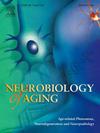阿尔茨海默病脑脊液生物标志物水平和APOE遗传状态与海马-小脑功能连通性相关
IF 3.7
3区 医学
Q2 GERIATRICS & GERONTOLOGY
引用次数: 0
摘要
最近的研究表明,海马体-小脑(Hp-CB)功能连接可能在阿尔茨海默病(AD)的早期过程中发生改变,因为阿尔茨海默病病理在海马体的早期积累以及新出现的阿尔茨海默病早期小脑变化的证据。本研究分析了AD遗传风险(通过APOE ε4载体状态)和AD病理的脑脊液(CSF)生物标志物(磷酸化tau蛋白(p-tau181)与淀粉样蛋白(a - β42/ a - β40)的比值)在161名认知功能未受损老年人(M年龄=67.3;SD = 9.0;37 % apoe ε4 +)。在以Hp-CB连通性为结果的多元回归分析中,年龄与APOE ε4状态、年龄与CSF AD生物标志物之间存在显著的相互作用。年龄越大,APOE ε4非携带者和CSF AD生物标志物异常较少的参与者的Hp-CB连通性越高。相反,在ε4携带者和AD生物标志物异常较多的人群中,随着年龄的增长,Hp-CB连通性略有降低。此外,在所有组中,更大的Hp-CB连通性与更好的情景记忆表现有关。这些发现表明,APOE ε4非携带者和AD生物标志物水平低的人群中,年龄相关的Hp-CB连接增加反映了与AD无关的年龄相关变化,而APOE ε4携带者中年龄相关的Hp-CB连接减少可能反映了AD相关的变化。这些发现还强调了小脑对老年人认知表现的重要性,并表明Hp-CB连接可能在临床前AD中发生改变。本文章由计算机程序翻译,如有差异,请以英文原文为准。
Alzheimer’s disease cerebrospinal fluid biomarker levels and APOE genetic status are associated with hippocampal-cerebellar functional connectivity
Recent research suggests that hippocampal-cerebellar (Hp-CB) functional connectivity may be altered early in the course of Alzheimer’s disease (AD), given the early accumulation of AD pathology in the hippocampi and emerging evidence of cerebellar changes in early AD. This study analyzed the role of AD genetic risk (via APOE ε4 carrier status) and cerebrospinal fluid (CSF) biomarkers of AD pathology (ratio of phosphorylated tau (p-tau181) to amyloid beta (Aβ42/Aβ40)) on the relationship between age and functional Hp-CB resting state fMRI connectivity in 161 cognitively unimpaired older adults (M age =67.3; SD =9.0; 37 % APOE ε4 +). In multiple regression analyses with Hp-CB connectivity as the outcome, there were significant interactions between age and APOE ε4 status, and between age and CSF AD biomarkers. Older age was associated with greater Hp-CB connectivity in APOE ε4 non-carriers and participants with less abnormal CSF AD biomarkers. In contrast, Hp-CB connectivity was marginally lower with older age in ε4 carriers and those with more abnormal AD biomarkers. Furthermore, greater Hp-CB connectivity was associated with better episodic memory performance across all groups. These findings suggest that age-related increases in Hp-CB connectivity among APOE ε4 non-carriers and those with low AD biomarker levels reflect age-related changes that are largely unrelated to AD, while age-related decreases in Hp-CB connectivity in APOE ε4 carriers may reflect AD-related alterations. These findings also highlight the importance of cerebellar contributions to cognitive performance among older adults and suggest that Hp-CB connectivity may be altered in preclinical AD.
求助全文
通过发布文献求助,成功后即可免费获取论文全文。
去求助
来源期刊

Neurobiology of Aging
医学-老年医学
CiteScore
8.40
自引率
2.40%
发文量
225
审稿时长
67 days
期刊介绍:
Neurobiology of Aging publishes the results of studies in behavior, biochemistry, cell biology, endocrinology, molecular biology, morphology, neurology, neuropathology, pharmacology, physiology and protein chemistry in which the primary emphasis involves mechanisms of nervous system changes with age or diseases associated with age. Reviews and primary research articles are included, occasionally accompanied by open peer commentary. Letters to the Editor and brief communications are also acceptable. Brief reports of highly time-sensitive material are usually treated as rapid communications in which case editorial review is completed within six weeks and publication scheduled for the next available issue.
 求助内容:
求助内容: 应助结果提醒方式:
应助结果提醒方式:


